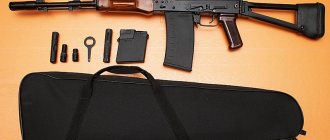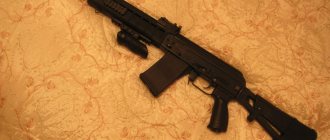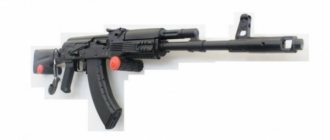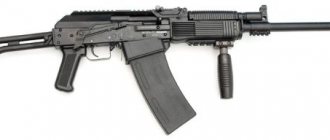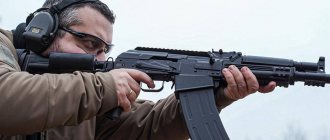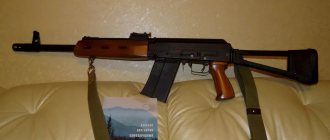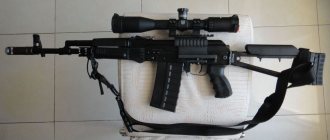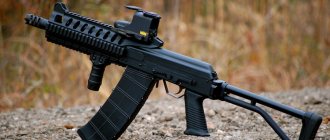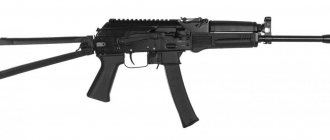Saiga-410 smoothbore carbine – a toy or...?
The subject of today's review will be a fairly well-known and no less discussed weapon - the Saiga-410 . Some argue that this is a self-sufficient hunting weapon, while others say that it is a toy for “shooting games” and recreational shooting. Who is right – let’s try to figure it out today.
Saiga-410 - a toy or a serious firearm?
I will not dwell in detail on the description of the structure and operating principles of this weapon, since it is known to almost everyone who is at least a little interested in domestic guns. I will only note interesting features, including that of my particular specimen.
I would like to start the conversation with the fact that the Saiga-410, which will be discussed, is from the very first batch (produced in 1994) with a long barrel (and a long paradox), a plastic stock and an awkward butt. It was taken specifically as a hunting barrel, and therefore the choice fell on it (although the Saiga model range in 410 caliber is quite wide, I was not immediately interested in units with an AK angle to the detriment of functionality).
Weapon Features
So, as already mentioned, my carbine is equipped with a non-folding stock and a non-folding butt of a hunting type. Personally, for me, it is extremely convenient, and I don’t see any point in installing anything instead of it. At the same time, the gun immediately came with an additional fire control handle. With it, the Saiga becomes much more compact, but in this form it is only suitable for recreational shooting, but not for hunting.
By the way, it is worth noting that it is very difficult to change the buttstock to the handle in the field (and why not, it’s difficult at home too). It fits into the steel elements of the box with great tension, and it is unlikely that it will be possible to remove it “by hand” even if you want to - you have to carefully and for a long time hit it with something wooden through something soft. At the same time, the hunting stock itself is removed by hand or, in extreme cases, by small light taps. This sharp difference is caused by the different methods of attaching the butt and handle, respectively. If you wish, you can combine two in one and purchase a hunting-type folding stock, but personally I don’t need this.
The second feature that I would like to note is the bolt, or more precisely, the inertial firing pin. Unlike other carbines of the Saiga series (I can’t speak for everything, but on those that I have seen, as well as on my 7.62x39, the firing pin moves freely), it is spring-loaded and extends only at the moment the trigger is hit, after which it returns to its original position .
Such a device has both a plus and a minus. The advantage is that when manipulating the bolt, the primer does not become punctured (I think everyone who took an unfired cartridge out of a rifled Saiga could see that a slight puncture appears on the primer from the firing pin - not critical, but not very pleasant either). Here, such a phenomenon is absent in principle. The downside is the fact that if the primer is hard, under-puncture is possible, and, as a result, a misfire (although I have never seen such situations, especially considering the primers used in the 410 caliber, but still).
The third thing I would like to say is that Saiga-410 is a huge field of creativity for lovers of all kinds of upgrades. So, it has a standard side rail installed for the sight bracket. The upper sighting bar is similar to the bar of a regular smoothbore, and if desired, you can mount anything on it (though, again, it is not present on all models, but I’m talking about mine). Again, it is convenient to attach either a laser laser (as in the photo below) or flashlights to the barrel. Fortunately, there are plenty of all kinds of body kits that can be installed on this carbine.
The last thing I would like to mention is the paradox attachment. With it, the Saiga (with good quality of execution, of course) allows you to confidently shoot bullets at fairly long distances (from my own experience, I can say – up to 90 meters accurately), and also shoot well with shot cartridges. Regarding the latter, I can say that from a distance of 25 meters, the spread from a Saiga-410 with a long paradox and the spread from a 20-caliber smoothbore are almost identical in area. It makes no sense to compare with ordinary small-caliber smoothbore shotguns (for example, 32). Thanks to the larger weight and, again, the dispersion of the shot when passing through large rifling, the paradoxical Saiga significantly surpasses them in shooting efficiency, even despite the smaller caliber (for those who do not know, the analogue of the 410 caliber in the usual system is the 36 caliber).
Ammunition for the Saiga-410 smoothbore carbine
Speaking about the Saiga-410 paradox as an effective weapon, one cannot fail to touch upon the issue of ammunition. So, in gun stores they are presented in a fairly wide assortment and, if desired, you can select the desired number of shot and bullet for shooting from the paradox (it is worth remembering that you should absolutely not shoot through the paradox with bullets that are not specifically intended for it) .
At the same time, the price of cartridges for .410 caliber, both with shot and with bullets, is relatively affordable - around 25 rubles per cartridge (which is much less than the cost of cartridges for other newfangled “paradoxes”).
Also, if you wish, you can always equip cartridges for Saiga with a self-roller. In this case, their price turns out to be practically a penny (if we take into account shooting with bullets, then I order them for 7 rubles for the paradox; maybe you can find them cheaper). The cost of a shot cartridge is much less. The only thing you should know is that it is highly advisable to find or order normal plastic casings for a self-roller (again, I had to order via the Internet, since there are no plastic casings or cartridges for sale in our area). Barnaul aluminum (or whatever they are...) cartridges are extremely problematic to reload due to their very complex calibration - after a shot they ring loudly, and it is almost impossible to calibrate them with a ring by hand.
Saiga-410 and hunting
This topic is perhaps the most interesting and most controversial. But not for me. It so happened that when I started hunting many years ago, the older hunters who went with me had both 12 and 28, 32 caliber guns. And I saw very well how the latter worked on the hog, and on the duck, and on the hare. Of course, everyone understands that hitting with a 12 gauge is easier and, in some cases, “more reliable.” But even with a .410 caliber you can quite successfully hunt both feathers and small game. An additional advantage in hunting, say, a duck, is that the Saiga-410 smoothbore carbine is a semi-automatic, and if desired, 5 shots can be fired in a very short period of time (by the way, some people shoot like this - in doublets at once, although personally I don’t I do not support the practice).
In general, I want to note that the main niche of this weapon (and caliber) is upland game, waterfowl from the approach and small animals. I would not recommend hunting with it, for example, in the spring on draft or ungulates (although I know people who do this, and quite successfully). I’ll say it again - each weapon has its own purpose. There is no need to bend it.
Pros and cons of the Saiga-410 carbine
To summarize, I would like to briefly describe the positive and negative aspects of this weapon.
The obvious advantages include:
- Affordable prices for both new and used weapons. The latter can be taken in excellent condition and with almost zero damage for an amount much less than 10,000 rubles.
- Ammunition availability . Both price and availability in stores.
- Ability to load cartridges yourself . At the same time, the gun works great not only with special powders such as Sunar-410, but also with regular Sokol.
- Huge margin of safety . The massive barrel of the carbine is designed to withstand significantly higher pressures than those generated as a result of shooting.
- Versatility , which is very important for a hunting rifle. The Saiga-410 with the paradox perfectly shoots shot of all sizes and special bullets (in fact, this is where the whole advantage of the paradox lies - in versatility). In this parameter, Saiga completely surpasses the “paradoxes” in .366 caliber, where shotgunning is practically absent.
- High quality shotgun shooting . When shooting through the paradox, you get a good, wide and fairly uniform dispersion of shot, especially small numbers.
- Great opportunities for all kinds of tuning . This smoothbore rifle is a real paradise for body kit lovers.
- Reliable operation of automation . Personally, I have no complaints about this.
But speaking objectively, it is worth noting the disadvantages of this weapon. This:
- Large mass . Although I personally have no comments on this, I have heard from many people that the weight is too heavy for this caliber and I would like something lighter.
- Large dimensions . Purely hunting carbines Saiga-410 with a long barrel, pardox and awkward butt are longer than even the rifled Saiga-410.
- The difficulty of independently reloading cartridges into Barnaul metal casings and the small number of .410 caliber plastic casings on sale.
- The need to shoot from the paradox only with special bullets . And this should be remembered and remembered again, so as not to damage the smoothbore carbine.
- Poking . Despite the fact that they do occur during automatic reloading, they are rarely encountered on my carbine personally. While for some guns I heard extremely unflattering reviews, it probably all depends on the specific type of Saiga-410, or even on the batch. In any case, this can be treated by simply jerking the shutter.
Thus, in my personal opinion, the Saiga-410 smoothbore carbine has many more advantages than disadvantages, and is an excellent example of a domestic hunting weapon (for its hunting niche, of course).
What is drilling paradox
One of the interpretations: paradox (Greek) is a situation (statement, statement, judgment or conclusion) that can exist in reality, but has no logical explanation. In the broadest sense, a paradox is understood as a statement that diverges from generally accepted opinion and seems illogical (often only with a superficial understanding).
Where did the paradox come from in the weapons world and what is it?
In our firearms case, however, we are talking about a special type of rifling of the barrel bore. It is believed that it was invented (at least patented in 1885) by the British gunsmith George Vincent Fosbury. He was a heroic man, a military officer, he fought bravely in India, and received the Victoria Cross for his services. In between exploits, he engaged in hunting, as befits a British officer; fortunately, there were few other civilized entertainments in the colony.
And it was hunting that gave him the idea to build a weapon that, on the one hand, could fire shot at a bird, and on the other hand, put a bullet into a tiger at a distance of at least fifty steps. Here we must take into account that big cats are tenacious creatures and resistant to wounds, so the projectile had to hit not just anywhere, but in the killing zone, the dimensions of which are traditionally small. An ordinary shotgun with a smooth bore did not have sufficient accuracy, and the rifle, for all its advantages, did not allow shooting shot. Therefore, Sir George simply proposed to cross a smooth-bore weapon with a rifled weapon: make a series of wide, steep rifling close to the muzzle of the shotgun. Accuracy and accuracy when shooting with a bullet increase, and you can shoot with shot. True, the shot sheaf was scattered quite strongly and unevenly along the edges; the scree when fired was rather unsatisfactory. Nevertheless, I liked the idea: in 1886, the first shotguns with Fosbury rifles appeared on the market and at first began to be in steady demand among hunters.
However, the idea did not last long. Everything “universal” is worse than specialized, and with the advent of double-barreled large-caliber guns that operated on smokeless powder and produced significantly greater muzzle energy and bullet speed, “paradoxes” sharply lost their popularity. Wealthy buyers preferred to have a separate gun with good shot firing and a shotgun that fired a bullet far and accurately, rather than one gun with mediocre characteristics. In addition, “Indian hunting”, in which it was customary to shoot at everything that moves, is not very common in the world. In general, fashion has passed...
Why do they use such a drill now?
Paradoxes found a rebirth already in the twentieth century with the advent of replaceable choke constrictions on the market. New technologies have made weapons more accessible and reliable. Shotguns sharply increased their versatility: the same gun could be used for a variety of types of hunting, producing, depending on the shooter’s desire, either wide or narrow scree; It was enough just to screw a choke of the required diameter into the barrel.
At the same time, the number of poor gun owners around the world has increased, who, on the one hand, could afford to have a hobby such as hunting, but for the money they could only afford one gun. At the same time, they were very interested in increasing the effectiveness of their weapons “at an inexpensive price.” This is where the Fosbury cut attachments come in handy. In Russian conditions, “paradoxes” arouse interest among shooters also because of the peculiarities of the legislation: let me remind you that before purchasing a full-fledged rifle, you have to own a “smoothbore” for 5 years.
What should the “paradox” be?
Here we are, first of all, limited by Russian legislation. A weapon is considered smooth-bore if the length of the rifled section of the barrel is no more than 140 mm. And the size, shape and pitch of the rifling is a purely individual thing, depending on the bullet used, the caliber and the wishes of the manufacturer. Ideally, the rifling should give the bullet rotation around its longitudinal axis at high speed (more than 20,000 rpm); at the same time, a full-fledged gyroscopic effect is activated, and the projectile begins to “self-center” in flight, like a children’s top. To do this, in principle, you can use short nozzles with steeper rifling, but there is a high risk of the bullet falling off the rifling. Long nozzles with a gentler pitch of rifling are perhaps preferable. You can select the necessary nozzle on the page.
What bullet is needed for the paradox?
Initially, caliber “caps” were used for shooting, that is, hollow cylindrical bullets with wide leading bands and a conical head, the diameter of which coincided with the diameter of the weapon’s barrel. It is now possible to make such bullets at home, for example, a 12-gauge bullet for a paradox bullet.
Their head part could be stamped from sheet metal: such a ballistic tip improved the aerodynamic properties of the bullet. There could also be an expansive cavity in the head part (to improve “flight characteristics” it was usually filled with wax or paraffin). Over time, the design became more complicated: in some cases, plastic stabilizer shanks began to be attached to the body of the bullet. Also, shooters experimented a lot (and not always successfully) with shooting bullets of conventional designs through a rifled nozzle, including sub-caliber ones, the body of which was enclosed in a plastic container. For example, it turned out that domestic Polev bullets of different models (already showing good accuracy and accuracy) in combination with the “paradox” are capable of showing even better results.
Domestic gunsmiths (both factory and amateur enthusiasts) also experimented a lot - the result was the appearance of very successful bullets from the Grizzly series.
What caliber is the paradox best suited for?
In general - for anyone, as long as the bullet matches. However, in my experience, this attachment is most often used by owners of .410 caliber shotguns: the ammunition is quite weak, a light bullet with low energy gives quite strong dispersion even at relatively short distances... And this is where a shooter who wants to improve the performance of his weapon can help "Fosbury cutting". Choke tubes for 410 caliber.
True, you won’t be able to get by with “magazine” ammunition here; it’s better to load the cartridges yourself and experiment with the material/height of the wad and the powder load. Some modern domestic manufacturers claim that the .410 with the “paradox” will magically be able to accurately shoot at a distance of up to 350 meters, but here I have a healthy skepticism: the bullet may reach it, but where will it hit? Here on the “hundredth”, rifled attachments really give a serious increase in accuracy. This is already a fait accompli.
